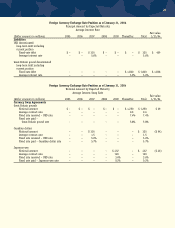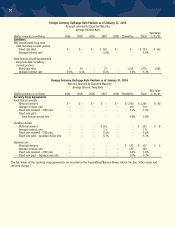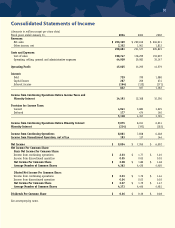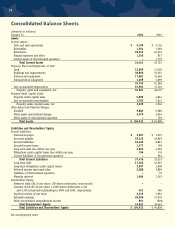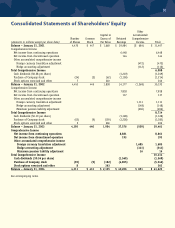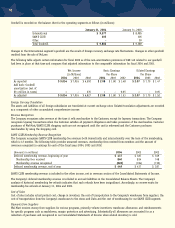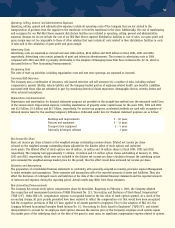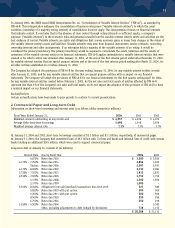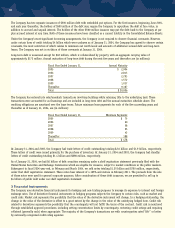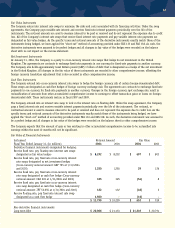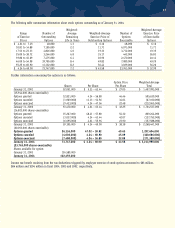Walmart 2004 Annual Report Download - page 41
Download and view the complete annual report
Please find page 41 of the 2004 Walmart annual report below. You can navigate through the pages in the report by either clicking on the pages listed below, or by using the keyword search tool below to find specific information within the annual report.
39
Operating, Selling, General and Administrative Expenses
Operating, selling, general and administrative expenses include all operating costs of the Company that are not related to the
transportation of products from the supplier to the warehouse or from the warehouse to the store. Additionally, the cost of warehousing
and occupancy for our Wal-Mart Stores segment distribution facilities are included in operating, selling, general and administrative
expenses. Because we do not include the cost of our Wal-Mart Stores segment distribution facilities in cost of sales, our gross profit and
gross margin may not be comparable to those of other retailers that may include all costs related to their distribution facilities in costs
of sales and in the calculation of gross profit and gross margin.
Advertising Costs
Advertising costs are expensed as incurred and were $966 million, $676 million and $618 million in fiscal 2004, 2003 and 2002,
respectively. Advertising costs consist primarily of print and television advertisements. The increase in advertising costs in 2004
compared with 2003 and 2002 is primarily attributable to the adoption of Emerging Issues Task Force Consensus No. 02-16, which is
discussed below in “New Accounting Pronouncements.”
Pre-opening Costs
The costs of start-up activities, including organization costs and new store openings, are expensed as incurred.
Insurance/Self-Insurance
The Company uses a combination of insurance, self-insured retention and self-insurance for a number of risks, including workers’
compensation, general liability, vehicle liability and the Company-funded portion of employee-related health care benefits. Liabilities
associated with these risks are estimated in part by considering historical claims experience, demographic factors, severity factors and
other actuarial assumptions.
Depreciation and Amortization
Depreciation and amortization for financial statement purposes are provided on the straight-line method over the estimated useful lives
of the various assets. Depreciation expense, including amortization of property under capital leases for the years 2004, 2003 and 2002
was $3.5 billion, $3.0 billion and $2.7 billion, respectively. For income tax purposes, accelerated methods are used with recognition of
deferred income taxes for the resulting temporary differences. Estimated useful lives for financial statement purposes are as follows:
Buildings and improvements 5 – 50 years
Fixtures and equipment 5 – 12 years
Transportation equipment 2 – 5 years
Internally developed software 3 years
Net Income Per Share
Basic net income per share is based on the weighted-average outstanding common shares. Diluted net income per share
is based on the weighted-average outstanding shares adjusted for the dilutive effect of stock options and restricted
stock grants. The diluted effect of stock options was 10 million, 16 million and 16 million shares in fiscal 2004, 2003 and 2002,
respectively. The Company had approximately 11 million, 10 million and 3.5 million option shares outstanding at January 31, 2004,
2003 and 2002, respectively, which were not included in the dilutive net income per share calculation because the underlying option
price exceeded the weighted-average market price for the period; thus the effect would have increased net income per share.
Estimates and Assumptions
The preparation of consolidated financial statements in conformity with generally accepted accounting principles requires Management
to make estimates and assumptions. These estimates and assumptions affect the reported amounts of assets and liabilities. They also
affect the disclosure of contingent assets and liabilities at the date of the consolidated financial statements and the reported amounts
of revenues and expenses during the reporting period. Actual results may differ from those estimates.
New Accounting Pronouncements
The Company has various stock option compensation plans for Associates. Beginning on February 1, 2003, the Company adopted
the recognition and measurement provisions of FASB Statement No. 123, “Accounting and Disclosure of Stock-Based Compensation”
(“FAS 123”). Under FAS 123, compensation expense is recognized based on the fair value of stock options granted. As a result of the
accounting change, all prior periods presented have been restated to reflect the compensation cost that would have been recognized
had the recognition provisions of FAS 123 been applied to all awards granted to employees. Prior to the adoption of FAS 123, the
Company followed Accounting Principles Board Opinion No. 25, “Accounting for Stock Issued to Employees” (“APB 25”), and related
interpretations to account for its employee stock options. Because the exercise price of the Company’s employee stock options equals
the market price of the underlying stock on the date of the grant in most cases, no significant compensation expense related to options


